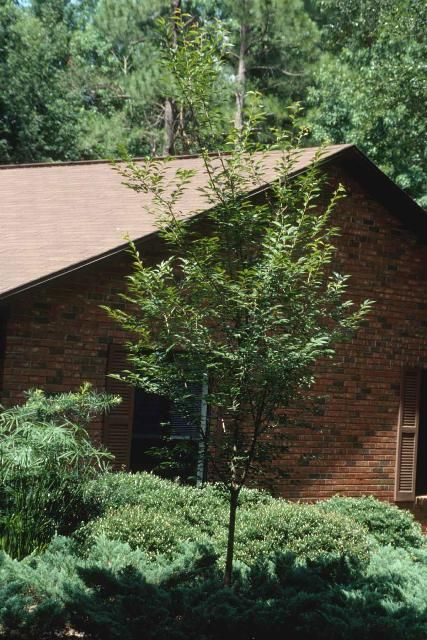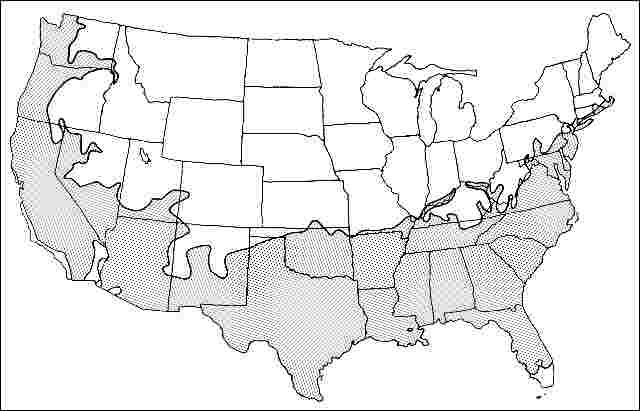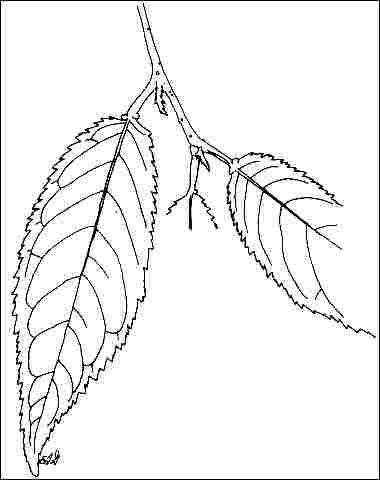Introduction
This hybrid of Prunus incisa and Prunus campanulata grows quickly when young and forms a 15 to 20-feet-tall and 20-feet-wide upright, oval silhouette. The dark green, 1 to 2.5-inch-long leaves cast medium shade beneath the tree, and turn lovely shades of yellow, orange, and red in the fall in the northern part of its range. In late winter to early spring, the trees are gaily decorated with a multitude of single pink blooms with red calyces and reddish flower stalks, making them quite outstanding in the awakening landscape. The trunk is wrapped with prominent lenticels raised above the smooth reddish-bronze bark. `Okame' Cherry is one of the most delicate and finest flowering trees available and one of the best for the deep south since it apparently has a low chilling requirement. It has been seen flowering in January and early February well into central Florida. Fall color is not showy in the southern part of its range but shows off nicely in the North.

Credit: Ed Gilman
General Information
Scientific name: Prunus x incamp
Pronunciation: PROO-nus x in-KAMP
Common name(s): 'Okame' Cherry
Family: Rosaceae
USDA hardiness zones: 6B through 9B (Fig. 2)
Origin: not native to North America
Invasive potential: little invasive potential
Uses: specimen; deck or patio; container or planter; screen; highway median
Availability: not native to North America

Description
Height: 15 to 20 feet
Spread: 15 to 20 feet
Crown uniformity: symmetrical
Crown shape: upright/erect, oval
Crown density: moderate
Growth rate: moderate
Texture: medium
Foliage
Leaf arrangement: alternate (Fig. 3)
Leaf type: simple
Leaf margin: serrate, double serrate
Leaf shape: elliptic (oval)
Leaf venation: pinnate, brachidodrome
Leaf type and persistence: deciduous
Leaf blade length: 2 to 4 inches
Leaf color: green
Fall color: yellow, orange, red, copper
Fall characteristic: showy
Flower
Flower color: pink
Flower characteristics: showy
Fruit
Fruit shape: round
Fruit length: less than .5 inch
Fruit covering: fleshy
Fruit color: unknown
Fruit characteristics: does not attract wildlife; not showy; fruit/leaves not a litter problem
Trunk and Branches
Trunk/bark/branches: branches don't droop; showy; typically one trunk; thorns
Pruning requirement: needed for strong structure
Breakage: resistant
Current year twig color: brown
Current year twig thickness: thin, medium
Wood specific gravity: unknown
Culture
Light requirement: full sun, partial sun or partial shade
Soil tolerances: clay; sand; loam; acidic; slightly alkaline; well-drained
Drought tolerance: moderate
Aerosol salt tolerance: unknown
Other
Roots: not a problem
Winter interest: no
Outstanding tree: yes
Ozone sensitivity: unknown
Verticillium wilt susceptibility: susceptible
Pest resistance: resistant to pests/diseases

Use and Management
To produce a nice specimen tree, prune to thin out the canopy and open it up to allow for light to penetrate to interior foliage. Remove upright oriented branches in favor of those with a wider angle with the trunk to form a pleasing, spreading habit. A more upright shape can be created by removing lateral branches. Remove interior branches and space main branches along the trunk.
Use the tree along an entrance road to a commercial development planted on 20-foot centers or along side the patio or deck in the back yard. It also makes a nice small-scale court yard tree or specimen planted in the lawn or in bed of ground cover. It could be planted along a residential street where there is plenty of soil for root expansion. It is generally available in the industry.
`Okame' Cherry can be grown in full sun in clay, loam or sandy soil but benefits from irrigation in dry weather. The tree benefits from some afternoon shade in the southern part of its range. Propagation is by softwood cuttings.
Pests and Diseases
No pests or diseases are of major concern. It is occasionally bothered by canker worms which can almost completely defoliate the tree.
Aphids cause distortion of new growth, deposits of honeydew, and sooty mold.
Borers attack weakened trees. Keep trees healthy with regular fertilizer applications.
Scales of several types infest the cherries. Horticultural oil is used for some control of scales.
Spider mites cause yellowing or stippling but they are very difficult to see.
Tent caterpillars make large webbed nests in trees then eat the foliage. One defoliation may not be serious and small nests can be pruned out and destroyed. Use Bacillus thuringiensis when the insects are first seen and are still small.